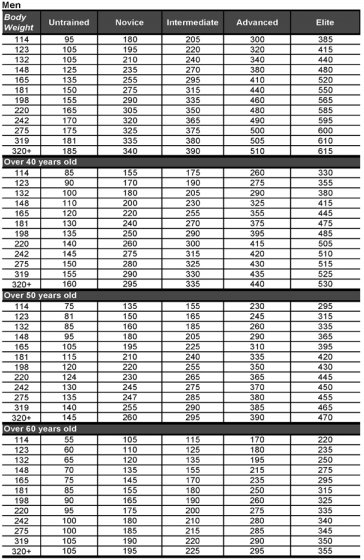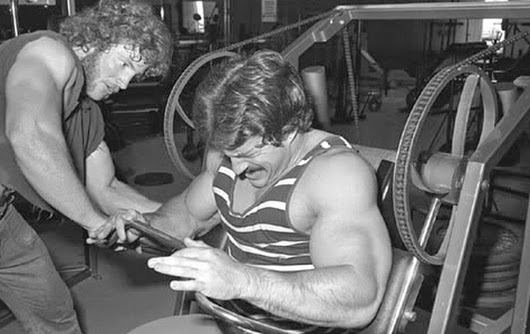How strong are you? – A Guide
Yesterday, I did a personal record deadlift of one rep at 320 pounds (145 kg for you metric types in the audience). My current weight is 161 pounds (73 kg), and I’m 61 years old. (Here’s a video from earlier this year in which I deadlifted 305.)
This deadlift been a long time coming for me, both in training to get the needed strength, and in overcoming a fear of injuring myself. Fear of injuring one’s back prevents most people from even attempting the deadlift, although that fear is way overdone, since there’s no reason you can’t start with a light weight – even with an unloaded bar, which weighs 45 pounds (20 kg).
Nevertheless, attempting heavy deadlifts should only be done by experienced lifters who know what they’re doing and use excellent form in the move.
Comparing strength
A personal record (PR) is one thing, but how does it compare to others? I doubt I’ll ever be any sort of first class competitive weightlifter, but it would be nice to know where I stand in the way of strength – whether I’m strong for my age, whether I need more work, whether my PR was a mediocre weight, etc.
Fortunately, we have some guidance in this matter from Lon Kilgore, PhD, whose doctorate is in anatomy and physiology and who has coached and competed in weightlifting since the early 1970s. He has written numerous books, and among them he co-authored, along with Mark Rippetoe, the first two editions of Starting Strength, the best-selling book on weight training. (The 3rd and most popular edition is Rippetoe’s alone.)
Kilgore has developed a set of strength standards for the basic lifts, which we’ll take a look at.
The basic lifts for which standards are given include the deadlift, the squat, the bench press, and the (overhead) press, as well as for a couple of Olympic lifts, the power clean and power snatch. (Bodybuilders seldom do Olympic-style moves, which require high skill and extensive training, so we’ll be omitting those.)
The categories of strength standards are for untrained, novice, intermediate, advanced, and elite.
At my first glance at these charts, I was somewhat baffled as to how Kilgore determined his categories. Seemed a bit arbitrary. But on closer scrutiny, it turns out that he based his divisions on the normal distribution of strength, as in the following graph:

The immediate discrepancy I see with this normal distribution is that far more than 2% of the population is untrained – the real figure must be more like 95%, if we count everyone who never lifts any weights at all.
Therefore, the normal distribution seems much closer to the population that already lifts weights. An elite lifter isn’t in the top 2% of strength for the population, but more like the top .1% (2% of 5%).
So when you look at how much you can lift for each of these moves, you might consider the comparison population to be everyone who’s in your gym lifting weights. Maybe not exactly right, but seems reasonably close.
How do my deadlift results compare to the run-of-the-mill gym rat’s? Check out the following, which I snipped from one of Dr. Kilgore’s charts, showing deadlift standards for men, by age and category.

Since I’m over 60 years old, weigh around 165, and can deadlift 320, I’m allegedly an elite lifter for the deadlift. However, I’m going to take this with a large grain of salt.
One reason for the grain of salt is that I’m not much over 60, and that over 60 category runs all the way up to advanced old age and death. If I can’t lift more than an 85-year-old, then I’m in trouble.
Another reason is Dr. Kilgore’s statement, “Adjustments for the inevitability of aging are included.” To me, that statement means that there’s only so much you can do to stem the tides of aging. This is partially true, but on this site, we teach maximum-strength anti-aging.
There’s lots about aging that isn’t at all inevitable, and for most people, much of aging amounts merely to letting themselves go to pieces: no exercise, overweight, poor diet, and many other bad health habits.
Using the powers of guesswork, I’m going to say that I should compare myself to the over 40 age group, or if I was being really brash, the category simply designated “men”.
In the case of the over 40 group, I may be just barely squeaking into the advanced category for the deadlift, and in the case of all men, I’m definitely only intermediate.
Nonetheless, hardly anyone in my smallish gym, young or old, deadlifts over 300 pounds. In fact, hardly anyone deadlifts. So there’s some consolation for me.
My squats need work, as does my bench. (I actually mostly use a chest press machine.)
I haven’t included all of Dr. Kilgore’s charts, because they’re his, so I encourage you to go to his site and take a look at all of them and see where you stand. His charts include standards for women as well.
While these strength standards aren’t perfect, there’s probably no perfect way to make the comparison. The population is too heterogeneous, the number who lift weights is relatively small and changing, finer-tuned age categories may be needed. But they’re probably about the best anyone can do, so kudos to Dr. Kilgore for them. They take much of the guesswork out of knowing where you stand in terms of strength.
Barbells can be intimidating to many people
One last editorial note. One of the main reasons I wrote my book Muscle Up was to show that strength training is a uniquely healthful exercise that offers better protection against aging, obesity, and disease than does any aerobic form of exercise. For that reason, I advocate that everyone should train for strength – that includes anyone from teenage boys to little old ladies, and everyone in between.
As a consequence, I think that there may be too much emphasis on barbell training. To be sure, it’s a great way to train and I use it extensively myself. But many people are intimidated by barbells, and won’t go near them. If you tell people that the only “real” way to train for strength is to use Olympic-style barbells, then you’ve already lost a lot of people who stand to benefit greatly from strength training. In fact, you’ve lost the people who could use it the most.
In my view, it’s better to show people the benefits of strength training first. Let them use the Nautilus and other machines. Show them the compound lifts that they need to be doing. When the student is ready, he’ll find the barbell.














12 Comments
Great stuff, PD. Have you read of/heard of Stuart McRobert? I read his book, Beyond Brawn, (which has a goof first-half, not so much second) and he talks about skeletal structure and offers general guidelines for strength similar to what you wrote above.
It was an eye opener for me and sobered me up to the fact that my body will only be able to hold a comfortable amount of weight (muscle) without causing further complications. (I was still coming from the old school Flex magazine images of ginormous guys.)
I’m all about that Frank Zane look!
If I’m reading those charts correctly, greater weight is associated with greater strength – which is what I’d expect in the NFL, but not among a group of truly untrained (and likely obese) people.
Good point.
That is very impressive. Congrats!
I have a question / topic for a post: What would you advice to your 30 year old self? What do you wish you knew already then?
I’ve understand that most of your current knowledge is summed up in your (excellent!) books, but is there something else that you wish your 30 year old self would have done/known, that your 60 year old self would have benefited from? Can be health related, but maybe even more interesting are also the other aspects of life.
I’d be curious to know your opinion!
Best wishes,
Robert
Robert, thanks. As a matter of fact, I’ve been thinking of a post just like you describe. I see writings from 35-year-old men who discuss “things I wish my 20-year-old self knew”, along those lines, and I kinda have to laugh. There’s a whole lot I’d wish I’d known when younger, from health and fitness to women and money. So, I’ll do that.
Low carb, low carb, low carb!
I shudder to think of all the carb-loaded crap I used to eat – bagels, pretzels, cereal, “health bars”, etc.
I imagine the body weight parameter in the charts refers to lean weight, not chubby weight.
After three months being back in the gym for the first time since high school (~25 yrs ago), I’m hitting my old numbers and starting to surpass them. I’m right at the intermediate lower limit, some exercises are slightly over, some exercises are slightly under.
Two things stand out compared to when I was a teenager. My strength has increased a lot faster than it did back then — I was a text book “hard gainer.” Depending on your point of view my stamina is greatly increased, or my peak performance is greatly decreased. Back then I could do _considerably_ more weight once than I could do for 4 reps. Today, the difference between the two is surprisingly small. If I can do it once, I can do it 4 times, and if I knock 10 lbs off I can do it 12 or even more. It could be some mental, not wanting to hurt myself, but it feels deeper, like my peak exertion just ain’t what it used to be. I’m looking at the glass as half-full and am concentrating on my greatly increased stamina. 🙂
To be a touch more specific about it, inspired by this post, yesterday I set-out to see if I could dead-lift over 200. I dead-lifted 205lb for 4 reps. I weigh ~127.
I think it would be cool to be able to do 250 by the end of summer, but 290 to become a fully qualified “Advanced” lifter… well, that sounds and feels pretty far away. Lifting 300 does have a nice ring to it.
Last weekend I was doing power-cleans of 115 in sets of 4. I wasn’t trying to max-out at all, just see how it would feel. My senior year in high-school I got the point where I could power-clean 115 in 10-8-6 sets. It took me a while to get there though. IIRC, it was a whole semester of working up to it. I can’t remember if I ever did 135. I definitely want to get to 135 by the end of summer. My goal is actually 155 for one rep. And again, 175 for “Advanced” feels pretty far away.
Hey, Allan, that’s very cool to do a DL 205 fer reps at your weight, especially just starting. You must be skinny – unless you’re 5’1″, which I’m guessing you’re not. You’re strong for your weight. 300 does have a nice ring to it, I never would have dreamed at one time that I could ever lift that much. Keep us posted.
5′ 10″. Built like a runner.
You’re not going to have to worry about developing more muscle than your skeleton and joints can carry unless you’re hitting the juice really hard.